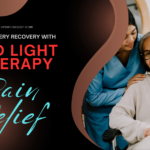
How to Enhance Sleep Quality and Duration with Red Light Therapy
Introduction
Ever found yourself lying awake, wanting a good night’s sleep? Sleep deprivation can harm your body and mind. But, there’s a natural way to get better sleep. Red light therapy is changing how we think about sleep.
Our screens and artificial lights mess with our sleep. Yet, research shows red light therapy can fix this. It uses special light to help your body sleep better, feel more energetic, and be healthier.
Key Takeaways
- Red light therapy is a non-invasive treatment that exposes the skin to low-level red light wavelengths.
- Red light therapy has been shown to improve sleep quality, increase melatonin production, and enhance endurance performance.
- The therapy works by stimulating cells’ mitochondria, increasing energy availability and potentially offering various health benefits.
- Red light therapy has emerged as a promising solution for sleep enhancement, with research indicating its ability to improve sleep quality and duration.
- Red light therapy can help regulate your circadian rhythm, leading to better sleep without disrupting your body’s natural sleep-wake cycle.
Red Light Therapy and Sleep Improvement
Red light therapy is becoming a popular way to improve sleep. It uses a specific light wavelength that goes deep into the skin. This helps boost energy in cells, which can help your body sleep better.
The Science Behind Red Light Treatment
Red light therapy boosts serotonin, a key mood and sleep regulator. It also lowers cortisol, a stress hormone that can keep you awake. Even though it’s not like sunlight, it still helps your body’s natural sleep cycle.
How Red Light Differs from Other Light Therapies
Red light therapy has a shorter wavelength than infrared therapy. This means it only goes a little way into the skin. It’s designed to target sleep without messing with your natural sleep patterns.
The Connection Between Light and Sleep Cycles
Studies show red light doesn’t mess with your body’s clock. This makes it safe to use in the evening. Unlike blue light, which can make it hard to fall asleep, red light can help you sleep better by boosting serotonin and lowering cortisol.
Image courtesy of NOVAALAB LLC
The Impact of Light on Circadian Rhythm
Your circadian rhythm is a 24-hour cycle that tells your body when to sleep and wake. Sunlight helps reset your internal clock and keeps you awake. Darkness, on the other hand, tells your body to start making melatonin for sleep.
But, blue light from screens can mess with your sleep. It has a short wavelength and high energy. This can stop your body from making melatonin and disrupt your sleep cycle.
Red Light Therapy for restful sleep and Red Light Therapy for sleep therapy don’t mess with your circadian rhythm like blue light does. Red light has a longer wavelength and lower energy. This means it doesn’t affect your sleep-wake cycle as much.
This makes red light therapy great for keeping your circadian rhythm healthy. It’s especially helpful for people who are around too much artificial light.
“Studies have shown that red light can induce alertness, with some participants showing increased brain activity when exposed to saturated red light.”
Some people think red light therapy helps them sleep better. But research says it mainly helps by not messing with your circadian rhythm. Unlike other lights, red light doesn’t affect your body’s natural sleep-wake cycle.
- Red light therapy works best when done daily in the morning for those who are “phase-delayed.”
- For those who are “phase-advanced” and get tired early, afternoon or evening sessions might be better.
Knowing how light affects your circadian rhythm helps you use Red Light Therapy for restful sleep and Red Light Therapy for sleep therapy better. It can help you keep a healthy sleep-wake cycle and improve your sleep quality.
Scientific Evidence and Benefits
Many studies have shown that red light therapy can greatly improve sleep. It is especially good for people with insomnia and sleep apnea.
Research-Backed Sleep Benefits
A 2020 study with 123 people aged 18-65 found red light therapy to be very effective. It improved sleep onset, total sleep time, and sleep efficiency. The study used PSG data to show its benefits.
Melatonin Production and Red Light
Red light therapy helps the body make more melatonin. This is unlike blue light, which can stop it. It helps keep a natural sleep-wake cycle.
A meta-analysis of 15 studies with 598 Alzheimer’s patients also showed benefits. It found better sleep efficiency and reduced depression and agitation.
Pain Reduction and Sleep Quality
Red light therapy can also help with chronic pain, which often disrupts sleep. Studies have shown it can reduce pain, helping people sleep better.
It also helps with jet lag and seasonal affective disorder (SAD). Both can really affect sleep.
Image courtesy of NOVAALAB LLC
Comparing Red Light to Blue Light Exposure)
Many Americans spend over 90% of their time indoors. This means they’re often surrounded by artificial lights that can mess with their sleep. Blue light, from devices and indoor lights, can lower melatonin levels and upset our natural sleep cycle.
Red light therapy offers a natural light option that doesn’t harm melatonin levels. It has a warm glow, like a sunset, making it perfect for evenings. Research shows red light can boost natural melatonin production, unlike other lights.
This makes red light therapy a great natural way to improve sleep quality and length. It’s especially helpful for those with insomnia, mood issues, or just wanting better sleep. Adding red light therapy to your evening routine can help you enhance sleep with Red Light Therapy and get the restful sleep your body craves.
Image courtesy of NOVAALAB LLC
Frequently Asked Questions
What is red light therapy and how does it work?
Red light therapy is a non-invasive treatment. It exposes the skin to low-level red light. This stimulates the mitochondria in cells, boosting energy and offering health benefits.
How does red light therapy differ from other light therapies?
Red light has shorter wavelengths and penetrates less than infrared therapy. Red light boosts serotonin and lowers cortisol, a stress hormone that can harm sleep.
How does red light therapy impact the circadian rhythm?
Red light therapy has little effect on the circadian rhythm. It’s safe for evening use without disrupting sleep. Unlike blue light, red light doesn’t block melatonin production.
What are the sleep-related benefits of red light therapy?
Red light therapy can help with insomnia and sleep apnea. It supports natural melatonin secretion and reduces chronic pain. It also helps reset the body’s internal clock for jet lag.
How does red light therapy compare to blue light exposure?
Blue light from screens can harm sleep by blocking melatonin. Red light therapy offers a natural alternative. It doesn’t affect melatonin, improving sleep quality and duration.
Additional Information
Additional Information
- https://pmc.ncbi.nlm.nih.gov/articles/PMC3499892/ – Red Light and the Sleep Quality and Endurance Performance of Chinese Female Basketball Players
- https://rouge.care/blogs/rouge-red-light-therapy-blog/red-light-therapy-for-sleep-the-safe-and-natural-way-to-better-rest – Red Light Therapy for Sleep: The Safe and Natural Way to Better Rest
- https://www.spectraredlight.com/red-light-therapy-for-better-sleep/ – Red Light Therapy for Better Sleep – Spectra Red Light
- https://pmc.ncbi.nlm.nih.gov/articles/PMC10484593/ – Effects of red light on sleep and mood in healthy subjects and individuals with insomnia disorder
- https://lightlounge.life/red-light-therapy/rejuvenate-your-body/sleep-improvement – Sleep Improvement with Red Light Therapy Beds. Light Lounge
- https://www.healthline.com/health/red-light-therapy – Red Light Therapy: Uses, Benefits, and Risks
- https://pmc.ncbi.nlm.nih.gov/articles/PMC2764401/ – Effect of Light Treatment on Sleep and Circadian Rhythms in Demented Nursing Home Patients
- https://www.sleepfoundation.org/light-therapy – Light Therapy for Insomnia Sufferers
- https://www.cnn.com/2023/06/01/health/red-light-therapy-benefits-sleep-wellness/index.html – How red light can affect your sleep | CNN
- https://www.frontiersin.org/journals/psychiatry/articles/10.3389/fpsyt.2023.1200350/full – Frontiers | Effects of red light on sleep and mood in healthy subjects and individuals with insomnia disorder
- https://pmc.ncbi.nlm.nih.gov/articles/PMC10699648/ – The effect of light therapy on sleep disorders and psychobehavioral symptoms in patients with Alzheimer’s disease: A meta-analysis
- https://www.lighttreeventures.com/post/the-sleeping-beauty-secret-the-red-light-therapy – Red Light Therapy | Sleeping Beauty Secret
- https://www.sleepfoundation.org/bedroom-environment/what-color-light-helps-you-sleep – What Color Light Helps You Sleep? | Sleep Foundation



































Unlock Exclusive Product Insights: Subscribe Now
Join our community of savvy shoppers! Subscribe to our monthly newsletter for expert reviews, top product recommendations, and exclusive deals delivered straight to your inbox. Don’t miss out on discovering the best products on the internet – sign up today and start shopping smarter!
You have Successfully Subscribed!
We promise not to spam you - only quality content to help you discover the best deals on the internet! Absolutely Free.